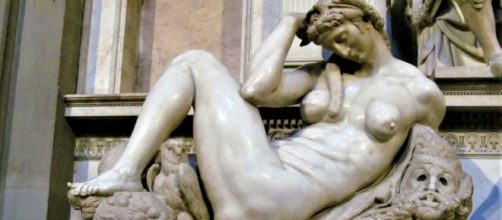Sculptors have tackled the same subjects through time, though inevitably with different outcomes. I say inevitably because they’re not only different people, but also because the times they lived in were different.
In broad daylight
A good example of time rearing its game-changing head is the difference between Michelangelo’s "Night and Day" (1520) and Jacob Epstein’s 1929 take on the same subject. You might say that they’re as different as night and day.
The 16th-century work, installed at the tomb of Giuliano di Lorenzo de Medici in Florence, is in the news now because an eight-year effort to restore the sculptures, ridding it of the ravages of time, has finally been completed.
To portray the times of day, Michelangelo pictures reclining nudes - a female for the night and a male for the day. But while her bent-down head indicates sleep, her torso is twisted as if in distress. The male’s torso also is twisted and gives a similar impression of distress. Perhaps they’re responding to each other?
Against the clock
Not that time always changes things. Epstein did what a lot of modern artists did: he dipped back into other cultures – in his case, to the Sphinx from the Old Nile. Even so, his version of night and day, like Michelangelo’s, depicts a nude figure, except they face front with exaggerated features that give the impression of appearing extra nude.
Another modern sculptor like Epstein, who borrowed styles from past times and envisioned a time of day with a human figure, is Aristide Maillol.
His "La Nuit" (The Night) portrays an introspective-looking female with her bent-down head, not unlike Michelangelo’s figure of night.
A night person
Exhibit notes from the Albright-Knox Museum, which holds Maillol’s "La Nuit," identify a different influence – “the inert massiveness of Egyptian sculpture.” I don’t see that. Most notable, though, is the fact that all three artists – Michelangelo, Epstein, and Maillol interpret night as female.
But wait, add one more sculpture of a male and female called "Night and Day," this one from Salvador Dali, which bears the sharp angles of Cubism. Despite the modern style, his description of male and female are oddly old-timey, stereotypical depiction of the male flexing his biceps and the female posing in a flirty kittenish way.
Time, though, is an irrefutable factor when it comes to matters of the heart. I’m thinking of the difference between Rodin’s “The Kiss” (1882) and Brancusi’s (1907) - 25 years later, a whole generation back then.
Time after time
Rodin’s adaptation is based on a story of forbidden love from Dante’s "The Divine Comedy: Inferno." Ergo, love doesn’t last. What you see is a woman’s forward motion with one of her legs draped over her lover’s, suggesting she is taking the initiative – knowing how the story ends colors it sad.
In contrast, Brancusi doesn’t bother with who did what in the embrace. His figures are so enmeshed they’re practically indistinguishable. "The Kiss," in this instance, is free of antecedents, which suggests that without constraints of tradition, love can transcend time.
I’ll end this on that happier note.


